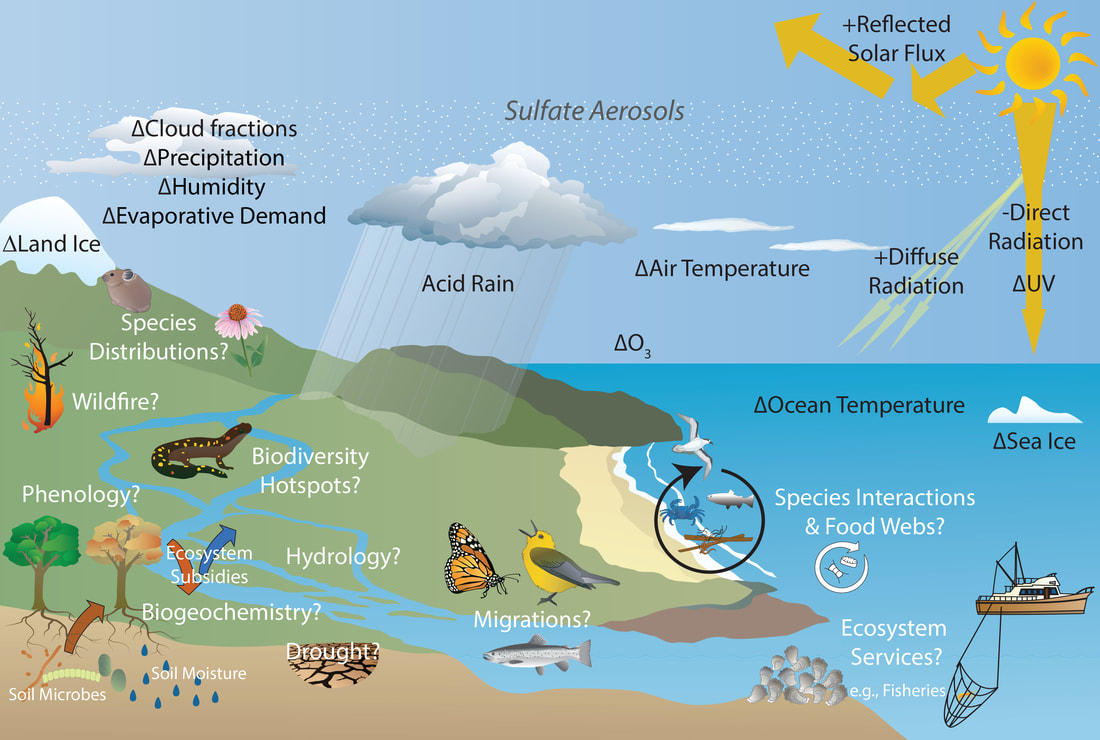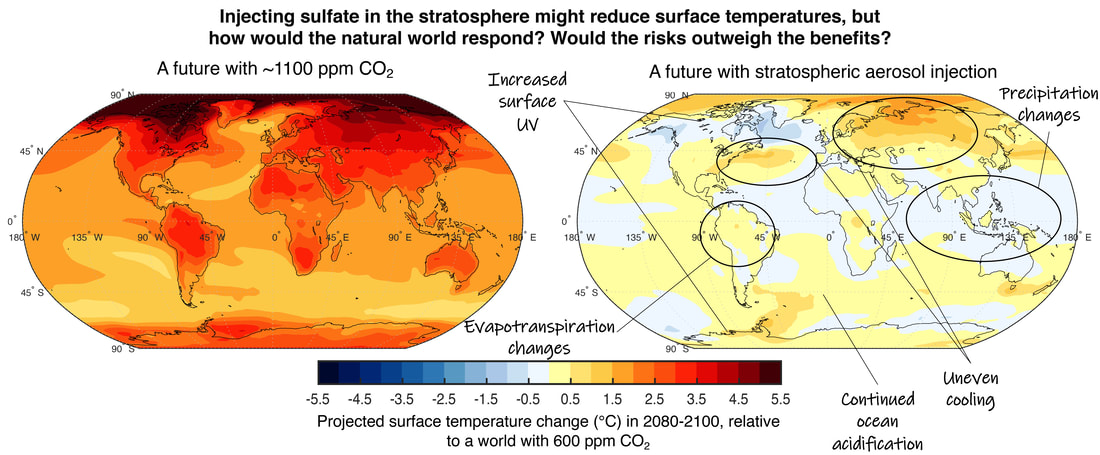back to SpaCE Lab Research Overview
Climate Intervention Biology
Climate change and associated global warming is caused by humans (IPCC 2013). The solution is to stop greenhouse gas emissions by eliminating dependence on fossil fuels (IPCC 2013, 2014). Climate intervention, or "geoengineering" is a set of proposed activities deliberately designed to counter the impacts of environmental change resulting from global warming. It has received increasing attention in the face of failure to limit the inputs of greenhouse gases to the atmosphere (NASEM 2021).
Many schemes for climate intervention have been proposed. There are two main groups of activities aimed at reducing the amount of carbon dioxide in the atmosphere: activities that focus on Carbon Dioxide Removal, CDR, including nature-based solutions like reforestation and afforestation, as well as direct CO2 capture; and activities aimed at partially reducing the amount of incoming solar radiation at the surface by increasing the albedo (reflectivity) of the Earth-atmosphere system in order to temporarily cool the planet (e.g., through Solar Radiation Modification, SRM, which includes Stratospheric Aerosol Intervention (SAI) and Marine Cloud Brightening (MCB)). In particular, SAI has received considerable study by climate scientists as a temporary strategy that may help forestall the worst impacts of anthropogenic climate change as emissions reductions occur. However, climate intervention alone will not remove all the impacts of anthropogenic climate change and should not be considered the solution. Emissions must stop for Earth’s temperature to stay within 1.5°C above pre-industrial levels (IPCC 2018).
Whereas climate science research on this topic has been ongoing for decades, there is a dearth of information on the potential impacts of climate intervention on ecological systems including risks to biodiversity and ecosystem functions and services.
In addition to researching this topic, Phoebe serves on a National Academy of Sciences, Engineering, and Medicine (NASEM) committee, Climate Intervention in an Earth Systems Science Framework: A Workshop.
By conducting research on the topic of climate intervention, we are filling important knowledge gaps; we do not endorse or advocate either testing or actual implementation of geoengineering.
Many schemes for climate intervention have been proposed. There are two main groups of activities aimed at reducing the amount of carbon dioxide in the atmosphere: activities that focus on Carbon Dioxide Removal, CDR, including nature-based solutions like reforestation and afforestation, as well as direct CO2 capture; and activities aimed at partially reducing the amount of incoming solar radiation at the surface by increasing the albedo (reflectivity) of the Earth-atmosphere system in order to temporarily cool the planet (e.g., through Solar Radiation Modification, SRM, which includes Stratospheric Aerosol Intervention (SAI) and Marine Cloud Brightening (MCB)). In particular, SAI has received considerable study by climate scientists as a temporary strategy that may help forestall the worst impacts of anthropogenic climate change as emissions reductions occur. However, climate intervention alone will not remove all the impacts of anthropogenic climate change and should not be considered the solution. Emissions must stop for Earth’s temperature to stay within 1.5°C above pre-industrial levels (IPCC 2018).
Whereas climate science research on this topic has been ongoing for decades, there is a dearth of information on the potential impacts of climate intervention on ecological systems including risks to biodiversity and ecosystem functions and services.
In addition to researching this topic, Phoebe serves on a National Academy of Sciences, Engineering, and Medicine (NASEM) committee, Climate Intervention in an Earth Systems Science Framework: A Workshop.
By conducting research on the topic of climate intervention, we are filling important knowledge gaps; we do not endorse or advocate either testing or actual implementation of geoengineering.
Project 1: NSF-funded Climate Intervention Biology Working Group
|
This NSF-funded research focuses on understanding and predicting potential impacts of climate intervention on ecological systems, from species to biomes. The Climate Intervention Biology Working Group consists of climate scientists and ecologists, co-led by Phoebe Zarnetske. See the working group's website which outlines the working group activities focused on studying the potential ecological impacts and risks of SAI and other solar geoengineering schemes: https://www.climateinterventionbiology.org/.
|

The effects of solar radiation modification (SRM) with stratospheric aerosol intervention (SAI) on ecological systems are largely unknown. Image Credit: Phoebe Zarnetske; symbols courtesy of the Integration and Application Network, University of Maryland Center for Environmental Science (ian.umces.edu/symbols/). This image is distributed under Creative Commons Attribution-NonCommercial-NoDerivatives License 4.0 (CC BY-NC-ND). See also Figure 1 in Zarnetske et al. 2021 PNAS: 10.1073/pnas.1921854118.

Change in projected surface temperature in 2080-2100 without mitigation (left) compared with a stratospheric aerosol injection scenario (SAI) (right). Although SAI may cool the planet down to a certain temperature target, there are potentially large impacts on ecosystems (right). Credit: Dan Visioni.
|
Project 2: Climate Change, Climate Intervention, & Marine Heat Waves
Marine heat waves (MHW) have major ecological impacts in marine ecosystems including biodiversity loss, changes in species behavior or performance, loss of genetic diversity and adaptive capacity, economic impacts from changes in fishery catch rates and mortality of species. Although climate intervention aims to reduce global mean temperature, some climate intervention scenarios may moderate extreme climatic changes such as heat waves. Yet quantifying the potential impact of climate intervention on marine heat waves (MHW) has not been addressed. The aim of this study is to estimate projected future MHW and their responses under climate change and two solar climate intervention schemes, stratospheric aerosol intervention (SAI) and marine cloud brightening (MCB). We are evaluating these potential futures during 2035-2069 from the earth system model: Community Earth System Model, version 2 (CESM2).
- Lab Members: Phoebe Zarnetske, Lala Kounta
- Collaborators: Cheryl Harrison, Amadou Gaye, Gouri Anil, Daniel Hueholt
- Funding: MSU Alliance for African Partnerships African Future Leadership Program, MSU EEB
- Project Website: https://www.climateinterventionbiology.org/
- GitHub: https://github.com/srm-ecology

The spatial anomaly in sea surface temperature according to different futures. Results are from the Earth System Model CESM2 ensemble and annual mean differences of future sea surface temperature (in 2035-2069) when compared with the current climate period (represented by SSP2-4.5 in 2015-2024). Panels represent a) a scenario without climate intervention (SSP2-4.5 in 2035-2069), b) a future SAI scenario (ARISE-SAI-1.5 for 2035-2069), and c) a future marine cloud brightening scenario (ARISE-MCB in 2035-2069). From Kounta, Zarnetske et al. in prep.
